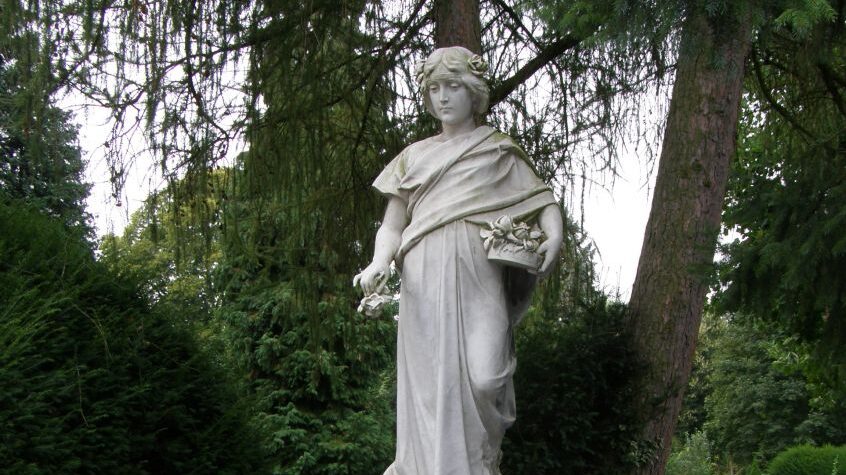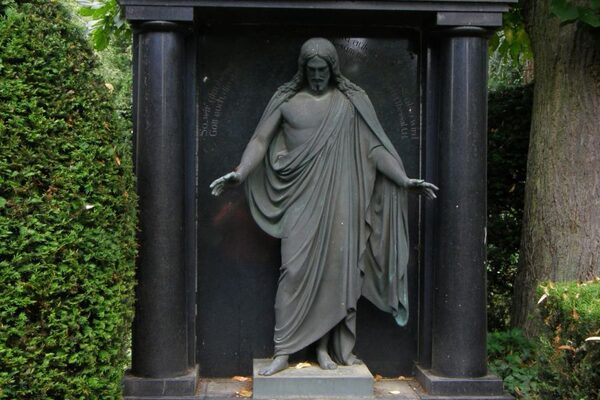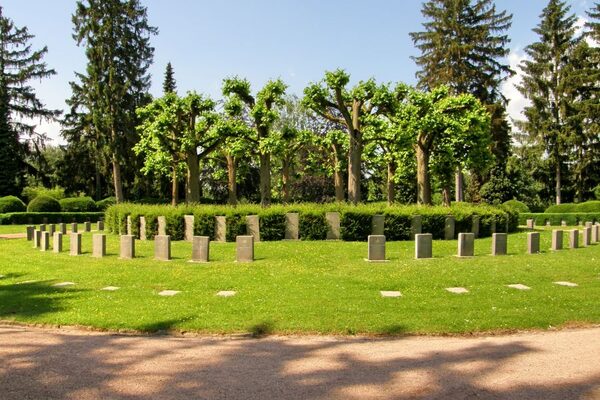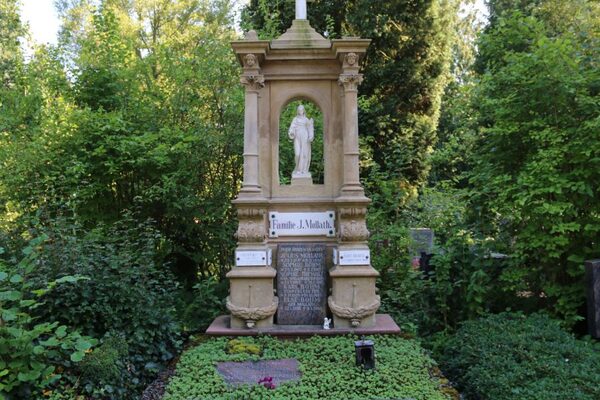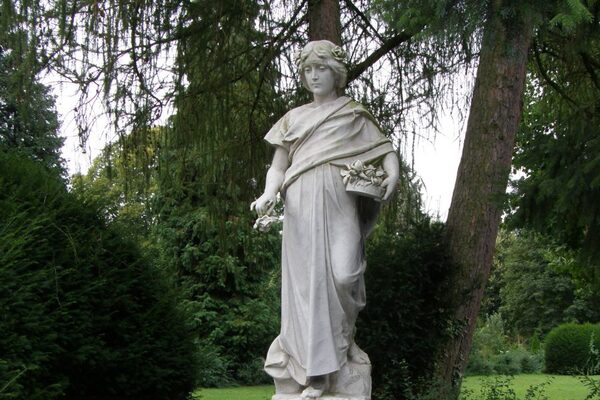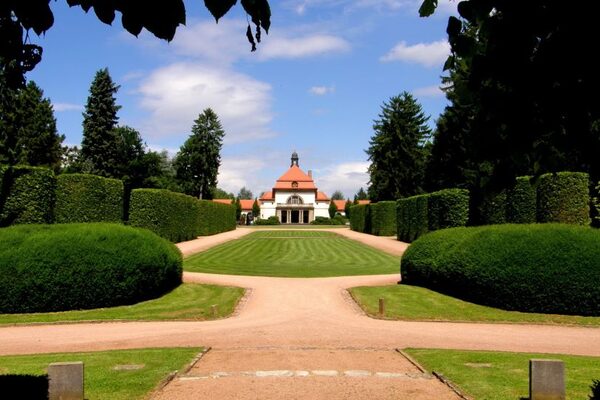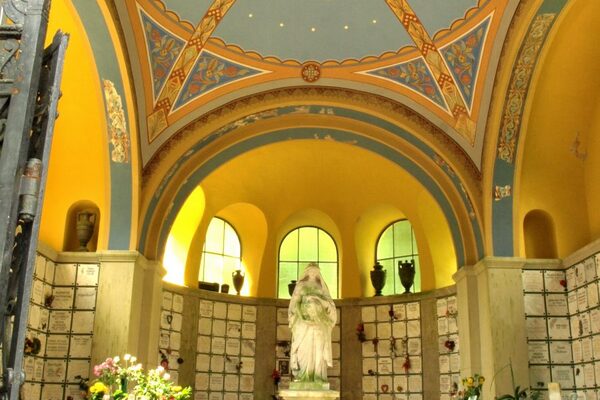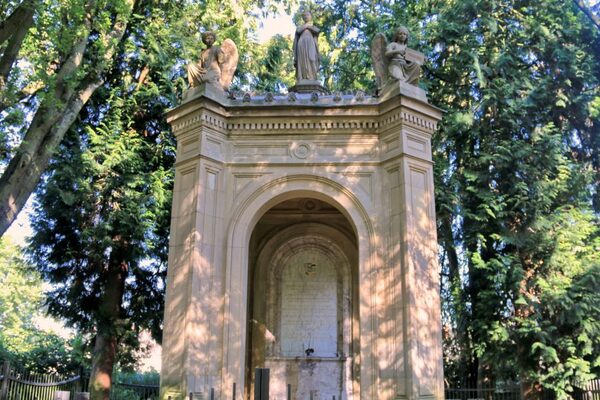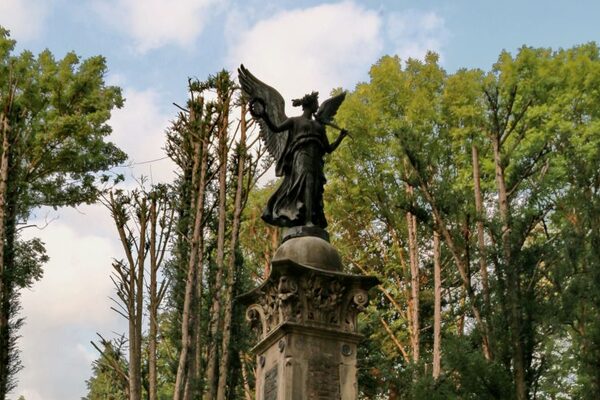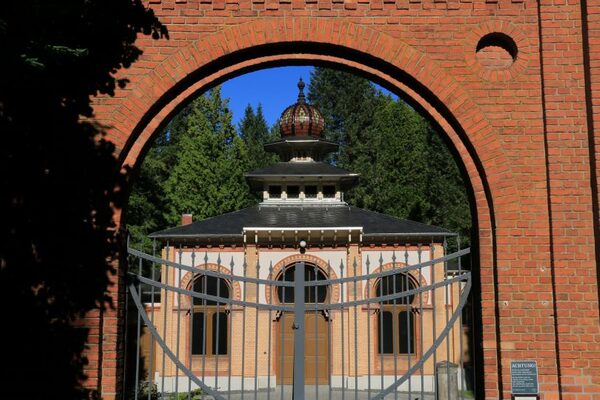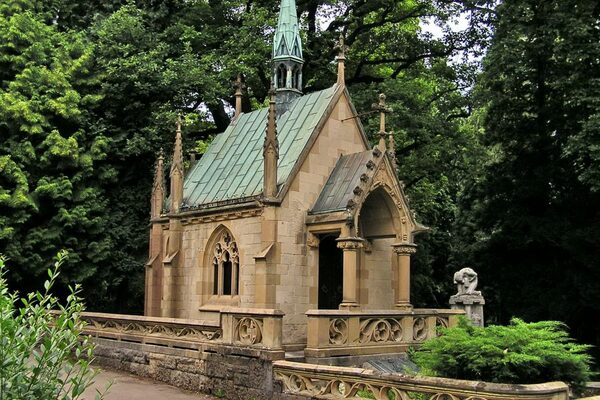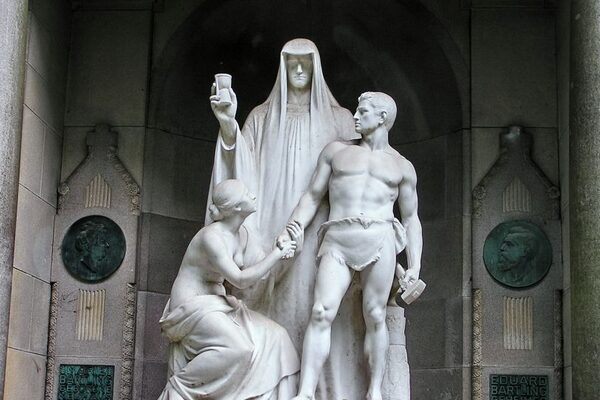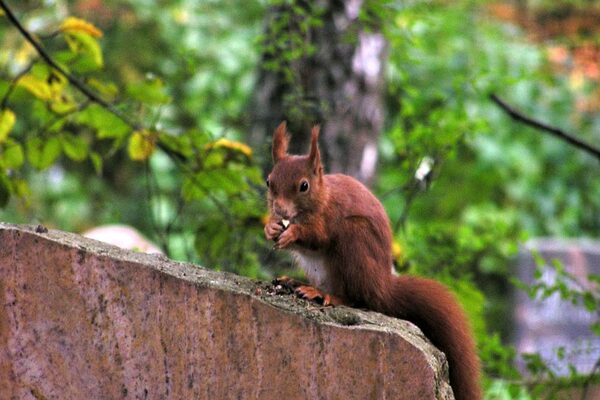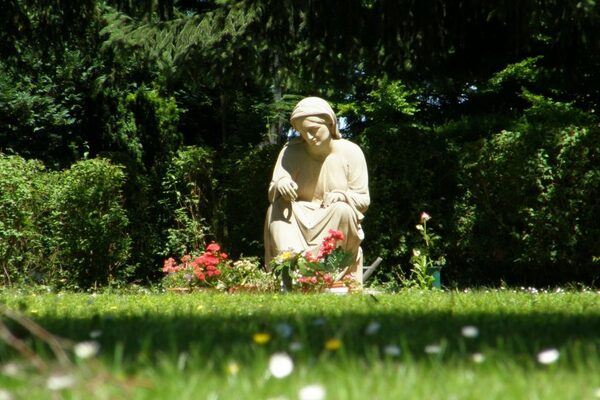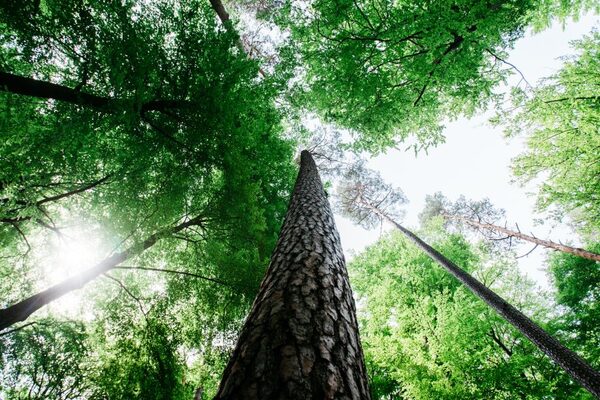Nature and cemetery culture
Listed graves
Numerous gravesites, especially in the large and old Wiesbaden cemeteries, are particularly worthy of preservation as monuments. Especially when it comes to burial culture, we humans have always been committed to the greatest artistic understanding since the beginning - we have been placing stones of remembrance for around 10,000 years.
The necropolises from the megalithic cultures as well as the impressive mausoleums in the northern cemetery, for example, which is now a listed building in its entirety, bear witness to this. Many other cemeteries in the city also have listed areas where special conservation requirements must be observed when designing new graves.
The Bernhard von Wiesen Foundation was set up in 2001 to ensure that future generations will have to worry less about the preservation of historical grave monuments and has already had a number of grave monuments conserved and restored. However, there is still much to be done, and the support of all and also civic commitment are needed. Further information can also be found at
Bernhard von Wiesen Foundation
Monument Preservation Hesse
War graves
The German Graves Act (GräbG), the long title of which is "Act on the Preservation of the Graves of Victims of War and Tyranny", regulates the commemoration of the victims of war and tyranny in a special way. War graves are not subject to any time restrictions and the graves may not be relocated. A war memorial therefore commemorates the soldiers who died in a war, not the civilian victims. War memorials are part of the landscape in almost all participating countries of the First World War. Many of them were also added to the Wiesbaden cemeteries to commemorate the fallen of the Second World War.
The function of a war memorial is multifaceted. It is intended to comfort relatives by giving meaning to the death of their loved ones. It should commit the survivors to the example of the victims and represent the state and its ideals. This is why there have often been conflicts over the erection of war memorials. Various social groups are still trying to foreground their understanding of war and society today. The many keywords include gratitude, mourning, the cult of the dead, heroes, nation, people and freedom.
Graves of honor and historic graves
Merits beyond death
The state capital of Wiesbaden currently maintains 26 graves of honor and 17 historic graves, which are located in the South Cemetery, the North Cemetery, as well as in the Biebrich, Mainz-Kastel, Dotzheim, Sonnenberg, Bierstadt, Kloppenheim and Russian cemeteries. The temporary restriction is important because not every grave of honor automatically remains a historic grave in the long term after the right of use expires.
An honorary grave is awarded by the magistrate in agreement with the Committee of Elders in accordance with the principles for awarding honorary graves in the state capital of Wiesbaden. Honorary graves are awarded to persons who have either rendered outstanding services to the state capital of Wiesbaden itself during their lifetime or who have been honored with a special grave for outstanding achievements in the (municipal) political, artistic, cultural, scientific, economic or social field.
An application is required for a grave to be recognized as an honorary grave. This can come from politicians or the general public and is submitted verbally or in writing to the magistrate's office.
These 43 special graves are therefore awarded to people whose honorable memory is to be preserved. The number of these graves can change, as these graves can also be cleared after the term of an honorary grave has expired. The preservation of historical gravesites is important with regard to the cultural heritage of the state capital of Wiesbaden. Such gravestones are no longer built today and are therefore of great importance from the point of view of monument protection: "Historically or artistically valuable gravestones and those whose preservation is important for folkloristic reasons must be placed under monument protection in good time in order to preserve them for posterity."
If it is decided that the grave no longer meets the requirements for recognition as a grave of honor, this grave can be classified as a historic or worthy of preservation by decision of the Cultural Office. The magistrate and the municipal council decide on selected honorary graves that have already existed for more than 50 years whether they will continue to exist as 'historic graves or gravesites with memorials worthy of preservation'.
Historic graves are graves of important or famous personalities. The Department of Culture has defined these gravesites for people who remained in the consciousness of the city's population in the field of culture and politics after their death because they earned lasting merit or achieved supra-regional significance beyond the city's borders, for example in their field of expertise.
Gravestones are classified as graves worthy of preservation according to the requirements of monument preservation and are therefore worthy of preservation. Each of these decisions, be it the awarding of a grave of honor or the decision as to whether the grave is to be continued as a historical or conservation-worthy grave and not cleared, is a case-by-case decision.
Sponsored graves
Sponsorships wanted
There is often no longer a family background for the numerous historical or artistically valuable gravestones and it is nevertheless important to preserve these buildings as monuments. Since 1991, the state capital of Wiesbaden has successfully practiced a sponsorship model for such structures whose right of use has expired or been returned. Now sponsors ensure that the historic grounds and the maintenance of their grave architecture are safeguarded. Upon conclusion of the sponsorship contract, the tomb and the structural installations become the property of the sponsor. By taking over the grave sponsorship, the grave sponsor secures the option to purchase this historic burial site for burials at a reduced price.
To date, around 140 listed gravesites in Wiesbaden have been sponsored. The majority of these are located in the North Cemetery. Around 250 of these picturesque graves worthy of protection, spread across all Wiesbaden cemeteries, are still waiting for the care of future sponsors.
Do you have any questions about the sponsored graves?
You can obtain further information and answers from the following contacts:
Parks Department
Cemetery administration
Telephone 0611 312993
friedhofsverwaltungwiesbadende
Building inspectorate
Lower monument protection authority and monument preservation
Telephone 0611 316492
denkmalschutzwiesbadende
Buildings
South Cemetery
The mourning hall forms the center of the symmetrically grouped complex at the South Cemetery. The central building is adjoined on both sides by archways, each of which is connected to a pavilion-like side wing. The wings, in turn, are adjoined by walled courtyards and two small porches on each side facing Siegfriedring, which are now used as stores for grave decorations.
The architect August O. Pauly was probably inspired by the symmetry of the garden view of Biebrich Palace for this grouping. The sculptures were created by the Wiesbaden sculptor Carl Wilhelm Bierbrauer (1881-1962). The façade is adorned with shell limestone reliefs depicting the procession of death. The mourning hall was decorated by the Wiesbaden painters Hans and Hanna Völcker.
The murals under the dome are particularly noteworthy. They refer to the motto that can be read in the south-east gallery: 'One generation passes, another comes / But the earth remains forever'. (Solomon 1:4). The dome is framed by a wreath of flowers, supported by 12 winged figures. The center is dominated by a large lighting fixture surrounded by angel heads. The frieze of figures runs through three sides of the mourning hall and, together with the dark gallery, defines the spatial structure. Wiesbaden's first crematorium was housed in the two basement levels below from 1912, where cremations were carried out until 1997.
Columbarium North Cemetery
A columbarium in the grounds of the North Cemetery is worthy of note. An urn house that originally held urns in 600 niches. Opened in 1902, it was designed by city architect Felix Genzmer and executed in the Nibelungen-like neo-Romanesque style.
However, some details such as the lettering already hint at the beginnings of Art Nouveau. The inscription above the entrance reads: 'Love never ceases' (Paul to the Corinthians, 1st letter, 13th chapter)
Pauline Mausoleum
The Pauline Mausoleum, actually the Duchess Pauline Mausoleum on the 'Old Cemetery', which is now a popular recreational area, was thoroughly renovated from the roof to the base by a specialist company in 2007. Numerous graffiti, structural damage and moss growth had taken their toll on the sandstone monument. Today, it is once again a sight to behold and a destination for many citizens interested in art history.
Alongside Duchess Pauline von Nassau, her son and daughter-in-law Countess Natalie von Merenberg are buried in the mausoleum. The tomb was designed in 1858 by the senior architect Carl Boos, who achieved national importance as an architect of Romanesque historicism. In Wiesbaden, he was responsible for the Marktkirche and the Nassau Ministerial Building in Luisenstraße, now the Hessian Ministry of Justice.
Memorial 1870/71
The almost ten-metre-high memorial (also known as the War Memorial or Victory Column) to the fallen of the Franco-Prussian War of 1870/71 towers on the north wall of the Old Cemetery. The war, which was declared and lost by France, culminated in the proclamation of the first German Emperor in Versailles and filled the Prussian treasury with reparations, which financed a large number of monuments throughout the empire commemorating the victory over Napoleon III.
The Berlin Victory Column with its gilded French cannon barrels embedded in the massive column is particularly vivid. Our monument at the Old Cemetery is made of granite, sandstone and bronze. It was commissioned by the city of Wiesbaden and ceremonially unveiled on October 18, 1874. It was designed by the Wiesbaden architect Christian Dähne, the execution was entrusted to the stonemason's workshop Knauer & Ross and the sculptural decoration is attributed to the sculptor Hermann Schies.
The square pedestal in the shape of an obelisk is based on a mound piled up from French rock. Commemorative plaques and imperial eagles were placed on all four sides and the battle sites of Wörth, Metz, Sedan and Paris can still be read underneath. The statue of Victoria, the goddess of victory herself, crowning the monument was purchased from Berlin and is certainly the work of Christian Daniel Rauch - the most influential Berlin sculptor of classicism, who also created the bronze deer at the Platte hunting lodge. The life-size statue of Victoria was cast in Berlin, while the other bronzes, inscription panels and the decorative eagle figures, some of which are unfortunately missing today due to vandalism, were probably created jointly by Schies and Rauch at the Castner foundry in Berlin.
The model for the Wiesbaden depiction of Victoria was six designs that King Frederick William II wanted to have erected in the park of Charlottenburg Palace. Two of these were realized and are said to bear the facial features of Queen Louise, who died in 1810. One of the two Berlin Victories bares her right leg and holds a victor's wreath and a palm branch as a sign of peace, which clearly proves the provenance of the Wiesbaden Victoria in the identical depiction at the Old Cemetery.
Jewish mourning hall Platter Straße
The only Jewish cemetery in Wiesbaden where burials still take place today is located to the north, adjacent to the grounds of the North Cemetery on Platter Straße. The new Jewish cemetery was inaugurated in 1891, and we particularly highlight the mourning hall on this site, which was only renovated in 2015.
The two-storey pavilion-like building made of clinker brickwork with gabled and hipped roofs and an onion dome on top is richly structured and charmingly decorated with bulbous fanlights in the windows and doors as well as projecting cornices.
For further information, please contact the Jewish Community of Wiesbaden.
Crypt chapel of the Kreizner family
Architect: Ludwig Euler (1844-1909)
Sculptor: W. Klostermann
Location: North cemetery, A35 plot 9
The burial plot of initially 58 m² was acquired by the Kreizner family on July 23, 1905 and extended by an area of 50 m² in 1907, so that the burial plot covers a total area of 108 m². The tomb, enclosed by a yellow sandstone wall, is a chapel in the neo-Gothic style with an underground accessible crypt. Hans-Georg Buschmann characterizes the crypt chapel in his work "Der Nordfriedhof von Wiesbaden und seine Vorgänger" (The North Cemetery of Wiesbaden and its predecessors) as follows: a building made of yellow sandstone in ashlar construction with a zinc sheet roof covering. The raised portal architecture, which compensates for the level, is framed by two columns with composite capitals, which stand on a low wall executed in tracery. The end is formed by a lambrequin with crabs and crowned with a cross.
The side walls of both the sanctuary and the apse are divided by tracery windows, whereby those in the apse are simpler than those in the sanctuary. A round window was also inserted in the rear of the apse. Both parts of the building end with a gabled roof. The roof of the prayer room supports a bell tower, the structure of which is adapted to the architecture of the building.
The supporting pillars of the chapel bear pinnacles decorated with crabs and crowned with finials. On the front pillars at the height of the eaves are lizards - a symbol of the sleep of death and resurrection. The interior walls of the crypt chapel are lined with slabs of Jura marble. In the apse is an altar made of stucco plaster with an inlaid altar slab made of dark basalt. The brightly colored round window shows a halo, and the other tracery windows were also decorated with colored stained glass. Unfortunately, large parts of it were destroyed by vandalism and have been replaced by safety glass.
The entrance leading to the crypt from the outside is closed by a door in the sloping wall. The door surface, made of a zinc-lead alloy, is richly decorated with tracery and leaf ornaments and bears the tomb inscription as well as a tomb verse inset below. A staircase leads down to the unadorned crypt, where 9 coffins and 2 urns have been buried to date. This unique mausoleum has been in the possession of the city of Wiesbaden again since 1994 and can be purchased as a sponsored grave.
Mausoleum of the Bartling family
Sculptor: Ernst Herter
Location: Northern cemetery, eastern park, plot 05, no. 001
The burial ground was acquired on 16.06.1902 (111 m², crypt size 36 m²) by the industrialist Eduard Bartling. In addition to his industrial ventures (he invented an excavator for mining brown coal and expanded a lime works near Limburg), he was very active both politically and socially. In recognition of this, he was awarded the title of Privy Councillor of Commerce by Kaiser Wilhelm II.
Hans-Georg Buschmann praises the temple-like complex (aedicula) made of light Bavarian granite in "Der Nordfriedhof von Wiesbaden und seine Vorgänger". The monoliths (columns) are made of the same material, but polished. The rear front is in the form of an apse. The roof is crowned with an urn on the right and left. The entrance to the crypt is at the back. An open staircase, flanked by corner pillars with decorative boxes for flowers, leads to the complex with a set group of figures.
This particularly artistically crafted group of three figures depicts a farewell scene. The central figure with the hourglass in his raised right hand represents death. To the right in front of it is a male figure dressed in an apron, holding a hammer in his left hand and looking at the hourglass. Behind him is a tree stump on which stands an anvil. Presumably the blacksmith of life is personified here. To the left, at the young man's feet, sits a female figure holding his right hand with both hands and holding on to him in life.
Today, the mausoleum is once again owned by the city of Wiesbaden and has been placed under monument protection in its entirety by the State Office for the Preservation of Monuments in order to preserve it as a cultural monument.
Nature conservation
Parks with a special ambience
Urban cemeteries are often one of the few opportunities for city dwellers to come into daily contact with a natural environment. Especially those cemeteries that have an old stock of trees. And the meticulously tended beds and hedges as well as the appealing meandering paths in our cemeteries often emphasize the character of special parks, which is why they are not only destinations for citizens who want to be close to their departed loved ones.
A special example is certainly the South Cemetery, which is the largest municipal cemetery in Wiesbaden with an area of over 30 hectares. With its dense tree population, old avenues, listed buildings and picturesque gravestones, it has not only been a unique place for burials since 1908, but today performs very similar ecological and climatic functions to our numerous forest meadow valleys.
Animals
In cemeteries, the entire designed landscape is geared towards a low-threshold soundscape and eternity. Behind the cemetery walls, far away from the noise of traffic, time seems to pass more slowly - a quiet and reverent atmosphere prevails here. The often exceptionally old trees and the natural graves offer numerous niches that have become rare biotopes in the city.
If you walk through our old Wiesbaden cemeteries with open eyes and pricked ears, you will soon realize that these zones, protected by tradition, ritual and, yes, taboos, are home to an astonishing diversity of species that often surpasses our parks. Many cemeteries are therefore the perfect habitat and retreat for animals. The artificially created and diverse landscapes offer living space and food for a wide variety of needs.
Birds in particular naturally feel at home there. It's not just the usual suspects that you notice: Cavity-nesting birds such as tits, woodpeckers and nuthatches, which easily find shelter in the old trees. The sparrow, the wren or the robin, which hide in the dense ornamental hedges, but also the more rare species such as the redstart, nightingale, yellow warbler or pied flycatcher. In any case, Wiesbaden's wildlife is particularly rich in species thanks to the warm climate at the gateway to the Rheingau. The permanent inhabitants of the inner-city area, which at 28% is relatively heavily wooded, include not only bats, moles, rabbits, squirrels, hedgehogs, stone martens, hamsters and dormice, but the cemeteries are also home to a number of rare, endangered species as well as exotic immigrants and returnees.
For example, the predominantly nocturnal red fox thrives in the southern cemetery. And the now rare fire salamander, various species of toad and frog and even the Aesculapian snake have also moved from their original habitats in the Taunus mountains to the water-rich and warm and humid urban area, finding new refuges in the cemetery grounds where they can reproduce largely undisturbed.
Plants
The appearance of Wiesbaden's cemeteries is also determined by the individual planting of the graves. Permanent planting, which can take up two thirds of the grave, is divided into two categories. Approximately half of the grave is usually used for ground cover, such as cotoneaster dammeri and ground-covering perennials. For shady locations, we recommend the carpeting golden strawberry (Waldsteinia ternata), for semi-shady locations, the common goutweed (Ajuga reptans) and for sunny locations, thyme, sedum species and the heather carnation (Dianthus deltoides).
Gardeners recommend slow-growing, small and pruning-tolerant shrubs such as yews, dwarf conifers, junipers or even boxwood as border planting. For permanent planting, it is important to ensure that the site conditions, i.e. the light and soil conditions, are right and that winter hardiness is taken into account when selecting plants for the cold season. In this way, the grave created should be a sight to behold all year round with its many shades of green, brown and rust without requiring much maintenance. The remaining area is usually highlighted in spring, summer and fall with seasonal flowering plants. For example, pansies, primroses, daisies, forget-me-nots and ranunculus in spring.
In summer, depending on the location, begonias, geraniums, lilies, male's fritillaries and marigolds are suitable. For the fall, there is the 'fall magic assortment'. This is a special selection that is very well suited to the fall season, including snow heather, fat hen, cyclamen, often combined with ivy, purple bells or even guelder rose. Flowering plants such as chrysanthemums and potted heather provide colorful accents. And various herbs in this mixture keep snails at bay. A welcome change for graves in partial shade are various grasses such as sedge and blue fescue or wintergreen ferns such as ribwort or worm fern.
Make sure the potting soil contains a high proportion of humus and fertilizer. Robust honeysuckle (Lonicerapileata), ivy (Hedera helix) and cotoneaster (Cotoneaster dammeri) are suitable ground cover plants. As it is rarely possible for the bereaved to water on all the hot days of the year, it is preferable to use succulent water-retaining plants such as the aforementioned honeysuckle. Follow the link to the cemetery statutes for specific preparation and care or ask the local cemetery gardener with confidence.
If relatives do not wish to maintain the grave themselves, it is advisable to conclude a grave maintenance contract with one of the local cemetery gardeners.
Trees
The ecological importance of Wiesbaden's cemeteries is also evident in the lush, sometimes exotic tree population. Among the approximately 10,000 trees, there are around 60 different species. Birch, spruce, maple, false cypress and hornbeam are particularly typical and frequently represented due to their allegorical significance for the burial tradition.
There are over 2,200 trees in the South Cemetery and more than 1,400 trees in the North Cemetery. In accordance with the various design intentions of the generations of employees entrusted with its care, the northern sections of the southern cemetery, for example, still have a dense population with a high proportion of conifers. The extended areas in the peripheral areas were then characterized by birch trees according to the taste of the next generations. In addition to the characteristically dense tree population, the plane tree avenue along the Ringweg and the columnar cypresses along the central axis are striking design elements of the southern cemetery.
The northern cemetery was even intentionally laid out as a woodland cemetery. More than half of the trees are conifers. Only a few beech and oak trees remain from the time before the cemetery was established. According to an old tradition, thujas (trees of life) and cypresses were often planted next to the graves, which today have often reached considerable proportions. Unfortunately, climate change does not stop at the cemetery wall. We are increasingly seeing the death of birch, spruce and cypress trees.
